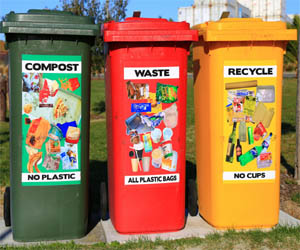


A Sustainable Solution For A Greener World

In a world facing the dual challenges of increasing waste generation and the urgent need for sustainable energy sources, fuel production from waste streams has emerged as a promising solution. This innovative approach not only offers a sustainable solution for waste management but also provides an opportunity to produce clean and renewable fuels, contributing to a more environmentally responsible and energy-secure future.
The Waste-To-Fuel Process
Fuel production from waste streams involves the conversion of various waste materials, including municipal solid waste, agricultural residues, and industrial by-products, into valuable fuels. This process may utilize various technologies, including pyrolysis, gasification, and biological conversion. The goal is to extract energy-rich components from waste materials and convert them into usable fuels, such as biofuels or synthetic fuels.
Diverse Feedstocks
One of the notable aspects of fuel production from waste streams is the versatility of feedstock materials. Different types of waste can be used, making this approach a flexible solution for waste management and energy production. Biomass, plastics, and organic waste can all be converted into fuels, diverting them from landfills and incineration.
Biofuels: A Renewable Option
Biofuels are a significant product of this waste-to-fuel process. They are typically produced from biological materials, such as plant residues or algae. Ethanol and biodiesel are common biofuels that can be used to replace or blend with traditional gasoline and diesel, reducing the carbon footprint of transportation.
Synthetic Fuels: A Clean Alternative
In addition to biofuels, waste-to-fuel processes can also produce synthetic fuels. Synthetic fuels, such as synthetic gasoline or synthetic diesel, are made from waste materials through chemical processes. These fuels are compatible with existing internal combustion engines and can be used in a wide range of applications, including transportation and industrial processes.
Environmental And Economic Benefits
Fuel production from waste streams offers a range of environmental and economic advantages. It contributes to waste reduction and diversion, mitigating the environmental impact of landfills and reducing the release of greenhouse gases. This approach also reduces the demand for non-renewable fossil fuels, decreasing carbon emissions and reliance on depleting natural resources.
From an economic perspective, converting waste materials into fuels creates opportunities for job growth in waste collection, processing, and fuel production industries. It can stimulate local economies and promote sustainable practices, contributing to a more resilient and vibrant society.
Challenges And Considerations
While fuel production from waste streams is a promising solution, it is not without challenges. Variability in feedstock quality, technological complexity, and the need for consistent waste sorting processes are among the issues that must be addressed for efficient and responsible fuel production.
Fuel production from waste streams is a significant step towards a cleaner and more sustainable energy future. By converting waste materials into valuable and renewable fuels, we reduce waste burdens, cut greenhouse gas emissions, and lessen our dependence on non-renewable resources. To fully unlock the potential of this innovative approach, ongoing investment in technology, research, and sustainable practices is essential. With continued efforts, we can transform waste into a valuable resource and make strides toward a greener, more sustainable world.
Unraveling The Mysteries Within
 Emotions, too, hold a place of great significance in the realm of the human mind. The mind can generate a vast spectrum of emotions, from love and joy to fear and sorrow. The secrets of emotional processing and the intricate neural pathways that govern these feelings continue to be a focal point of scientific research. Understanding the complexities of emotional intelligence and regulation remains a challenge, but it is a crucial step toward a deeper comprehension of the human psyche.
Emotions, too, hold a place of great significance in the realm of the human mind. The mind can generate a vast spectrum of emotions, from love and joy to fear and sorrow. The secrets of emotional processing and the intricate neural pathways that govern these feelings continue to be a focal point of scientific research. Understanding the complexities of emotional intelligence and regulation remains a challenge, but it is a crucial step toward a deeper comprehension of the human psyche.
Memory, another cornerstone of the human mind, conceals its own set of secrets. The brain's capacity to store and retrieve vast amounts of information is awe-inspiring, and yet, the mechanisms of memory formation and recall remain partially shrouded in mystery. Researchers are constantly exploring the brain's intricacies to uncover the secrets behind how we remember and why we forget.
The human mind also holds the power of perception. It processes the sensory input from our environment, shaping our view of the world. Perception is not a passive process; it involves the mind's interpretation of sensory data. The study of perception has revealed the mind's role in shaping our understanding of reality and how it can be influenced by our past experiences, beliefs, and expectations.
Consciousness itself is one of the most profound secrets of the human mind. While we experience it every day, the nature of consciousness and its origins remain a subject of ongoing debate and exploration.








What Your Feline Friend Is Saying
 Meowing: Meowing is perhaps the most well-known cat vocalization. Cats may meow to greet you, ask for food, or seek attention. The tone and intensity of the meow can provide clues about their feelings.
Meowing: Meowing is perhaps the most well-known cat vocalization. Cats may meow to greet you, ask for food, or seek attention. The tone and intensity of the meow can provide clues about their feelings.
Purring: Purring is generally a sign of contentment, but cats may also purr when in pain or discomfort, as it can be a self-soothing mechanism.
Hissing And Growling: These vocalizations are defensive and signify fear or aggression. A cat hisses or growls when feeling threatened or cornered.
Chirping And Chattering: Some cats make chirping or chattering sounds when they observe birds or small prey animals outside. It's believed to be an expression of excitement or frustration.
2. Body Language:
Cats use their bodies to convey a multitude of messages:
Tail Position: The position of a cat's tail is a significant indicator of their mood. A high, straight tail often means they are happy or confident, while a puffed-up tail indicates fear or aggression.
Ears: The position of a cat's ears is essential. Forward-facing ears suggest interest, while flattened ears signal anger or distress.
Whiskers: When a cat's whiskers are relaxed and fanned out, it often signifies contentment. When they are pulled back tightly against the face, it may indicate fear or aggression.
Eye Contact: A slow blink from a cat is a sign of trust and affection. Prolonged direct eye contact, on the other hand, may be seen as a challenge or a threat.
A Positive Reinforcement Approach To Effective Learning
 Timing Is Crucial: The click must be precise and timely, indicating to your dog that their action was correct. This immediate feedback helps them understand what they're being rewarded for.
Timing Is Crucial: The click must be precise and timely, indicating to your dog that their action was correct. This immediate feedback helps them understand what they're being rewarded for.
Reward: Follow the click with a treat, praise, or affection to reinforce the behavior positively. The dog learns that the clicker sound signals a reward.
Consistency: Be consistent with your clicks and rewards to prevent confusion. Click each time the desired behavior is performed.
Benefits Of Clicker Training
Clear Communication: Clicker training provides precise communication between you and your dog. The sound of the click is a clear marker of the exact moment your dog did something right, making it easier for them to understand what you expect.
Positive Reinforcement: Clicker training relies on positive reinforcement, creating a motivating and enjoyable learning experience for your dog. This promotes eagerness and enthusiasm during training sessions.
Accelerated Learning: Dogs quickly grasp which behaviors lead to rewards through clicker training. The speed of learning is often faster compared to traditional training methods.
Reduced Stress: Unlike punitive methods, clicker training minimizes stress and anxiety in dogs. It creates a positive and trusting training atmosphere.
Implementing Clicker Training Effectively
Condition Your Dog To The Clicker: Start by "charging" the clicker. Click and then immediately reward your dog several times without asking for any specific behavior. This helps them understand that the click equals a treat.
Paving The Way To A Sustainable Future
 Understanding The Climate Crisis: The climate crisis, characterized by rising global temperatures, is driven primarily by human activities, including the burning of fossil fuels, deforestation, and industrial processes. Its consequences, such as extreme weather events, sea-level rise, and ecological disruptions, pose serious threats to our environment, economies, and societies.
Understanding The Climate Crisis: The climate crisis, characterized by rising global temperatures, is driven primarily by human activities, including the burning of fossil fuels, deforestation, and industrial processes. Its consequences, such as extreme weather events, sea-level rise, and ecological disruptions, pose serious threats to our environment, economies, and societies.
Importance Of Climate Action: Climate action is paramount because the consequences of inaction are dire. Failing to address the climate crisis jeopardizes food security, water resources, public health, and the stability of ecosystems. Moreover, it deepens global inequality and exacerbates social and economic disparities.
Key Climate Action Strategies:
Transition To Clean Energy: One of the most critical climate action strategies is transitioning from fossil fuels to clean, renewable energy sources. Solar, wind, hydropower, and geothermal energy provide sustainable alternatives to carbon-intensive fuels. This transition reduces emissions and bolsters energy independence.
Exploring Self-Hypnosis Techniques
 Self-hypnosis, also known as autohypnosis, empowers individuals to enter a hypnotic state on their own, without the assistance of a hypnotist. It can be a valuable tool for relaxation, personal growth, and addressing specific challenges. Here are some key self-hypnosis techniques to consider:
Self-hypnosis, also known as autohypnosis, empowers individuals to enter a hypnotic state on their own, without the assistance of a hypnotist. It can be a valuable tool for relaxation, personal growth, and addressing specific challenges. Here are some key self-hypnosis techniques to consider:
Find A Quiet Space: Begin by selecting a quiet, comfortable space where you can relax without distractions. Whether it's a cozy chair, a soft carpet, or even your bed, the key is to ensure you won't be interrupted during your self-hypnosis session.
Set An Intention: Determine the purpose of your self-hypnosis session. What specific issue or goal would you like to address or achieve? Having a clear intention will guide your self-hypnosis process.
Relaxation And Breathing: Sit or lie down in a comfortable position. Close your eyes and take a few deep, cleansing breaths. With each exhalation, release tension and stress. Slow, deep breathing can help induce a state of relaxation.
Visualization: Begin to visualize a calming and serene place. This could be a beach, a forest, or any location where you feel at peace. Imagine the sights, sounds, and sensations of this place. Visualization helps deepen your relaxation.
Progressive Muscle Relaxation: Progressively tense and then release the tension in each muscle group in your body, starting from your toes and moving upward. This can enhance your state of physical relaxation.
Affirmations And Suggestions: With your mind in a receptive state, use positive affirmations and suggestions related to your intention. For example, if you're seeking stress relief, you might say, "I am calm and in control." Repeat these affirmations while maintaining focus on your intention.
Counting Down: Some individuals find it helpful to count down from a specific number, such as 10 to 1, as they enter a deeper state of relaxation. This counting can serve as a trigger for your subconscious mind.